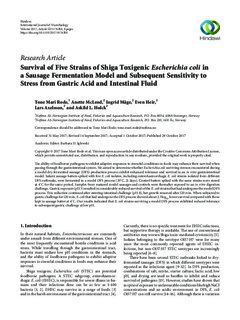Survival of Five Strains of Shiga Toxigenic Escherichia coli in a Sausage Fermentation Model and Subsequent Sensitivity to Stress from Gastric Acid and Intestinal Fluid
Peer reviewed, Journal article
Submitted version

Permanent lenke
http://hdl.handle.net/11250/2481255Utgivelsesdato
2017Metadata
Vis full innførselSamlinger
- Artikler / Articles [1425]
- Publikasjoner fra CRIStin [2488]
Sammendrag
The ability of foodborne pathogens to exhibit adaptive responses to stressful conditions in foods may enhance their survival when passing through the gastrointestinal system. We aimed to determine whether Escherichia coli surviving stresses encountered during a model dry-fermented sausage (DFS) production process exhibit enhanced tolerance and survival in an in vitro gastrointestinal model. Salami sausage batters spiked with five E. coli isolates, including enterohaemorrhagic E. coli strains isolated from different DFS outbreaks, were fermented in a model DFS process (20°C, 21 days). Control batters spiked with the same strains were stored at 4°C for the same period. Samples from matured model sausages and controls were thereafter exposed to an in vitro digestion challenge. Gastric exposure (pH 3) resulted in considerably reduced survival of the E. coli strains that had undergone the model DFS process. This reduction continued after entering intestinal challenge (pH 8), but growth resumed after 120 min. When subjected to gastric challenge for 120 min, E. coli that had undergone the DFS process showed about lower survival compared with those kept in sausage batter at 4°C. Our results indicated that E. coli strains surviving a model DFS process exhibited reduced tolerance to subsequent gastric challenge at low pH.